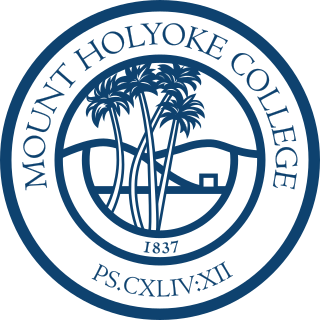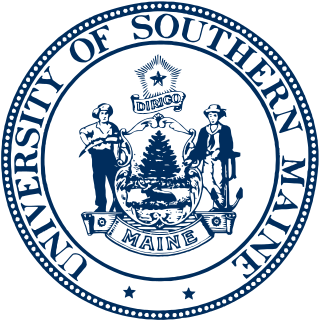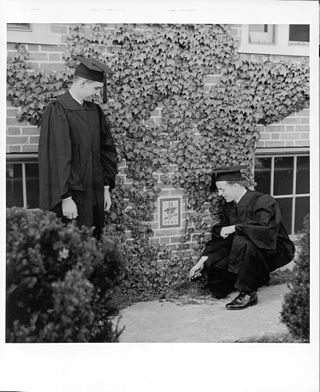
The University of California, Davis is a public land-grant research university in Davis, California, United States. It is the northernmost of the ten campuses of the University of California system. The institution was first founded as an agricultural branch of the system in 1905, known as University Farm, and became the seventh campus of the University of California in 1959.

Summit County is a county located in the U.S. state of Colorado. As of the 2020 census, the population was 31,055. The county seat and largest town is Breckenridge.

Mount Holyoke College is a private liberal arts women's college in South Hadley, Massachusetts, United States. It is the oldest member of the historic Seven Sisters colleges, a group of historically female colleges in the Northeastern United States. The college was founded in 1837 as the Mount Holyoke Female Seminary by Mary Lyon, a pioneer in education for women. Mount Holyoke is part of the Five College Consortium in Western Massachusetts.

Lewiston is the second most populous city in the U.S. state of Maine, with the city's population at 37,121 as of the 2020 United States Census. The city lies halfway between Augusta, the state's capital, and Portland, the state's most populous city. It is one-half of the Lewiston–Auburn Metropolitan Statistical Area, commonly referred to as "L/A." or "L-A." Lewiston exerts a significant impact upon the diversity, religious variety, commerce, education, and economic power of Maine. It is known for having an overall low cost of living, substantial access to medical care, and a low violent-crime rate. In recent years, the city of Lewiston has also seen a spike in economic and social growth. While the dominant language spoken in the city is English, it is home to a significant Somali population as well as the largest French-speaking population in the United States while it is second to St. Martin Parish, Louisiana, in percentage of speakers.

Bates College is a private liberal arts college in Lewiston, Maine. Anchored by the Historic Quad, the campus of Bates totals 813 acres (329 ha). It maintains 600 acres (240 ha) of nature preserve known as the "Bates-Morse Mountain" near Campbell Island and a coastal center on Atkins Bay.

The University of Southern Maine (USM) is a public university with campuses in Portland, Gorham and Lewiston in the U.S. state of Maine. It is the southernmost of the University of Maine System. It was founded as two separate state universities, Gorham Normal School and Portland University. The two universities, later known as Gorham State College and the University of Maine at Portland, were combined in 1970 to help streamline the public university system in Maine and eventually expanded by adding the Lewiston campus in 1988.

Carroll College is a private Catholic college in Helena, Montana. The college has 21 buildings on a 63-acre campus, has over 35 academic majors, participates in 15 NAIA athletic sports, and is home to All Saints Chapel. The college motto, in Latin, is “Non scholae, sed vitae.” The college translates this into English as “Not for school, but for life.” Carroll's colors are purple and gold and the school's athletics teams are known as the Fighting Saints.

WRBC is the college radio station of Bates College, located in Lewiston, Maine and at 91.5 MHz on the FM dial. The WRBC studio is located in the basement of 31 Frye Street across from the student coffee house, The Ronj. The WRBC board of directors publish an online music blog called The Monkey.
Elaine Tuttle Hansen is an American academic administrator, scholar and university professor who served as the executive director of the Center for Talented Youth at Johns Hopkins University from 2011 to 2018 and the 8th President of Bates College from 2002 to 2011.

Kentucky Mountain Bible College (KMBC) is a private Holiness bible college in Vancleve, Kentucky. It is a ministry of the Kentucky Mountain Holiness Association. The college claims that over 70% of its graduates have entered Christian ministry, including speakers, missionaries, and pastors in over 60 countries worldwide.

The Stephens Observatory is located atop the Carnegie Science Building at Bates College in Lewiston, Maine. It houses a 12 in (30 cm) Newtonian reflecting telescope, built by Roscoe G. Stephens of Kennebunk, Maine, and donated to the College in 1929. It is used mainly as a teaching facility for upper-level astronomy classes. The observatory has a modern tracking system and electronic drive mechanism.

Benjamin Edward Bates IV was an American rail industrialist, textile tycoon and philanthropist. He was the wealthiest person in Maine from 1850 to 1878.

George Colby Chase was an American intellectual and professor of English who served as the second President of Bates College succeeding its founder, Oren Burbank Cheney, from March 1894 to November 1919.

Maine Central Institute (MCI) is an independent high school in Pittsfield, Maine, United States that was established in 1866. The school enrolls approximately 430 students and is a nonsectarian institution. The school has both boarding and day students.

The Bates College Museum of Art is an art museum located on the campus of, and maintained by, Bates College in Lewiston, Maine. The museum's collection consists of works of art that showcase Maine as well as art from around the world, with a focus on modern and contemporary work. It holds 8,000 pieces and objects of contemporary domestic and international art. The museum holds over 100 original artworks, photographs, and sketches from Marsden Hartley. The primary focuses of the main collection are works on paper, including drawings, prints and photographs. The museum hosts a number of exhibitions each year and publishes catalogues for select shows. Additionally, the museum offers numerous lectures, artist symposiums, and workshops.

The Main Street–Frye Street Historic District is a historic district comprising houses on Frye Street and parts of College Street and Main Street in Lewiston, Maine. This area was part of the most fashionable residential district of the city in the second half of the 19th century, and was home to many of the city's elite. Its architectural styles are diverse, with a significant number of homes designed by local architect George M. Coombs. The district was added to the National Register of Historic Places in 2009.
Riverside Cemetery is a cemetery in Lewiston, Maine. The 40-acre (16 ha) cemetery is located on the bank of the Androscoggin River which flows through Lewiston. It is owned by the Riverside Cemetery Association.
Elmer I. Thomas (1863–1895) was an American architect who practiced in Auburn and Lewiston, Maine.

The history of Bates College began shortly before Bates College's founding on March 16, 1855, in Lewiston, Maine. The college was founded by Oren Burbank Cheney and Benjamin Bates. Originating as a Free Will Baptist institution, it has since secularized and established a liberal arts curriculum. After the mysterious 1853 burning of Parsonsfield Seminary, Cheney wanted to create another seminary in a more central part of Maine: Lewiston, a then-booming industrial economy. He met with religious and political leaders in Topsham, to discuss the formation of such a school, recruiting much of the college's first trustees, most notably Ebenezer Knowlton. After a well-received speech by Cheney, the group successfully petitioned the Maine State Legislature to establish the Maine State Seminary. At its founding it was the first coeducational college in New England. Soon after it was established, donors stepped forward to finance the seminary, developing the school in an affluent residential district of Lewiston. The college struggled to finance its operations after the financial crisis of 1857, requiring extra capital to remain afloat. Cheney's political activities attracted Benjamin Bates, who was interested in fostering his business interests in Maine. Bates donated installments of tens of thousands of dollars to the college to bring it out of the crisis.

The traditions of Bates College include the activities, songs, and academic regalia of Bates College, a private liberal arts college in Lewiston, Maine. They are well known on campus and nationally as an embedded component of the student life at the college and its history.

















